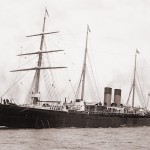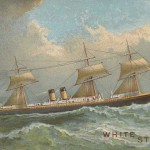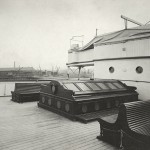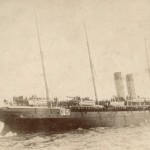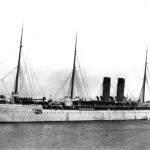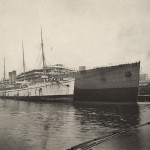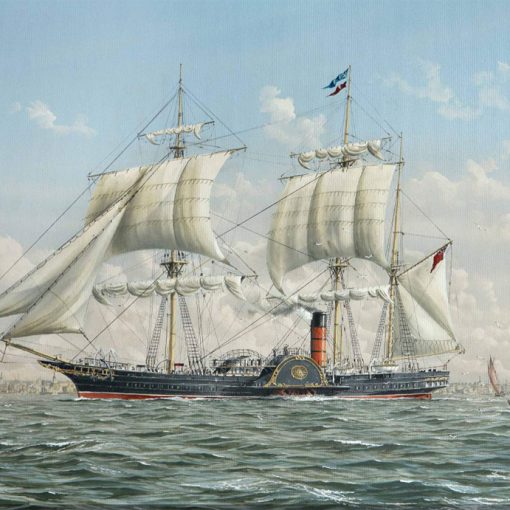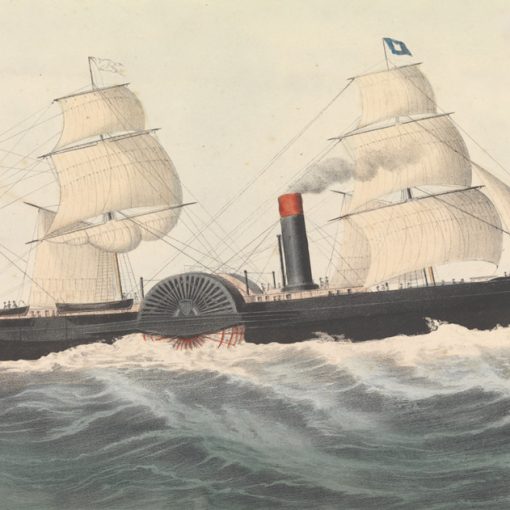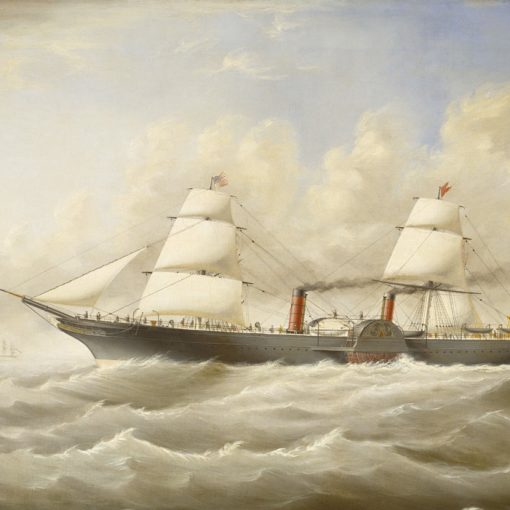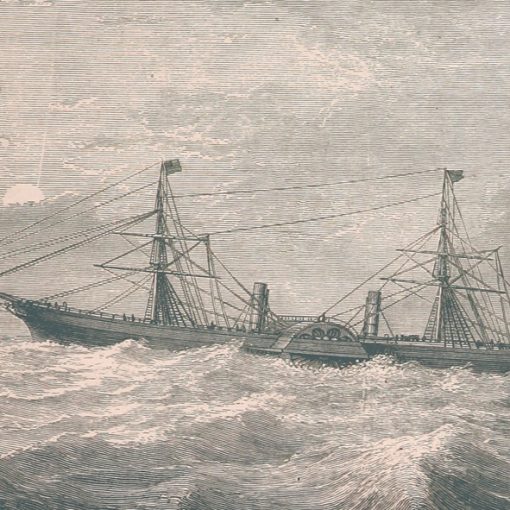1874 – 1903
By the mid-1870s, the White Star Line had grown considerably since the company was first founded 30 years earlier. The company was one of the most popular and respected of all operating on the North Atlantic. In 1871, the first Oceanic had made her maiden voyage from Liverpool to New York and she had soon been followed by three sisters – Atlantic, Baltic and Republic.
However, the competition was hard and other companies were soon building ships to match White Star Line’s quartet. To keep up with the pace, the company ordered two new ships from the Belfast-shipyard of Harland & Wolff. They were to become the sisters Britannic and Germanic. The Britannic was first intended to have the name Hellenic, but the name was changed before her launch. One can suspect that the two names given were thought to symbolise the friendship between Britain and Germany.
The first to be launched was the Britannic, on February 3rd 1874. The two new sisters represented the very latest in ship design, yet they still bore much resemblance to the old sailing vessels. Sir E.J. Harland, the ship’s designer, had based the two ships on a barque’s design, with four masts of which three were square-rigged.
But the Britannic and her sister had many modern features as well. Fitted with eight bulkheads, their iron hulls were divided into nine separate compartments, making them very safe ships. The Britannic was also equipped with an adjustable propeller shaft, so that the propeller could be lowered deeper on the open sea, thereby bettering its thrust. Although not the largest ship in the world, she was still the largest so far built by Harland & Wolff, with a gross tonnage of 5,004. To meet the competition, these two new ships were to be about 1.5 knots faster than White Star’s first quartet.
A little more than four months after her launch, the Britannic was ready for her maiden voyage. On June 25th 1874, she left Liverpool with New York as destination. However, the adjustable propeller didn’t work as planned, and after nine voyages the Britannic was taken in to have it removed. On June 9th 1876, she was returned to service, and the modification of her propulsion system had certainly brought improvements. During that year, she captured the Blue Riband, both westbound and eastbound, by averaging almost 16 knots.
The Britannic and her sister continued to serve the White Star Line with a remarkable reliability into the 1880s. But in 1881, the Britannic had her first taste of bad luck when she collided with the sailing vessel Julia near Belfast. Then, in July that year, she went aground while travelling through fog along the Irish coast. This incident caused some damage to the ship’s engine room, which sprung a leak. The Britannic was patched up and then towed to Liverpool for repairs. Because of this mishap, the company had to cancel her following voyage. As soon as the repairs had been made, the Britannic returned to service.
One and a half years later, the Britannic came to the assistance when her fleetmate Celtic (I) found herself in a predicament in the waters leading to New York. Celtic’s propeller shaft had snapped, and she had continued to Liverpool under sail. However, when the two ships met in mid-ocean, the Britannic took the Celtic in tow all the way back to Liverpool. When the Britannic left Liverpool after the ‘rescue’, a strange sound was discovered. After some investigation it was found that there was a crack in her propeller shaft, and the voyage had to be cancelled. Repairs were made, and the Britannic could set sail again. But her relationship with the Celtic was not over yet.
Four years later, in 1887, the Britannic was travelling at some 15 knots through foggy waters 300 miles from New York. Suddenly, her older fleetmate Celtic materialised from the heavy fog. To avoid collision, the officer commanding the Britannic ordered full speed ahead. But it was too late, and the Celtic rammed Britannic at right angles, thereby damaging her at waterline level, just aft of the superstructure. On board the Britannic, three steerage passengers were killed and another two were injured. In these days before wireless no help could be summoned, so the Britannic headed back towards New York, escorted by Celtic. At the following enquiry, both ships were censured for travelling through fog at too great speed.
Two years later, the Britannic suffered another accident when she collided with the brig Czarowitz in Liverpool Bay. The brig was sliced in half by the Britannic’s iron hull. But the following year, 1890, became a much happier one for the Britannic. Ever since her maiden voyage, her engines had performed better every year, and this year she made what was to become her fastest crossing ever – 7 days, 6 hours and 55 minutes with an average speed of 16.1 knots.
Five years later, when the Britannic had reached 21 years of age, she was taken in for a refit. Her funnels were heightened and she was given two extra lifeboats. Her sister Germanic was refitted with triple-expansion engines at the same time. This could have been done also to the Britannic, but work on the new Georgic was given higher priority.
In October 1899, the Britannic was requisitioned by the government to serve as a troopship in the Boer War. With her hull painted white and funnels all buff-coloured, she was turned into His Majesty’s Transport No. 62. In this guise, she made ten voyages. Later, in November of 1900, the Britannic was given the honourable task of representing Great Britain at the review in Sydney harbour that marked the inauguration of the Commonwealth of Australia. On that voyage, the Britannic transported the honour guard. However, the trip became a small embarrassment when the ship ran aground in the Suez Canal. Yet the voyage could be completed once she had been floated off.
Returned to White Star, the Britannic was sent to Belfast in October 1902. There she was to be fitted with triple-expansion engines, as her sister had been seven years earlier. However, the investigations of the ship showed that she was not in a very favourable condition. The Britannic was now rather old, and if she could not be fitted with new engines, she would be a hopelessly out-dated ship. So, it was instead decided to sell her as scrap. In July of 1903, she was sold to German scrappers for £11,500. The following month she was towed to Hamburg where she was to spend her dying days.
Specifications
- 455 feet (139 m) long
- 45.2 feet (13.8 m) wide
- 5,004 gross tons
- 2 x 2 cylinder tandem compound engine turning a single propeller
- 16 knot service speed
- Passenger capacity of 1,720 people

